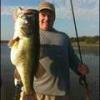WHAT?????? Using that set up, at least for me, would be asking to never land a nice bass on a trap. Using a heavy rod is bad enough for trap fishing, but to be using braided line with it, which has no stretch, is a great recipe for tearing those treble hooks out left and right.
More power to ya if this way of fishing works for you. For me though this make absolutely no logical sense at all
I however do agree on the larger hook. I always switch out the hooks for a larger size. Especially the front one.
From my experience skin hooked bass where the hooks tear out easily are usually the product of not having the heavy set up in the first place. The bass clamps down on the bait and your rod and line setup can't move the bait in the mouth of the fish so your hooks don't set until the bass opens it's mouth. Sometimes the bass will open its mouth and the hooks miss everything and you can't figure out why the rod bent and the hooks didn't hold. You think the hooks ripped out but what really happend was the hooks just missed after the fish opened up and let your bait go. If they do catch that way often they just barely catch on the way out of the mouth. When I set the hook with my set up the hooks almost always penatrate deep where they can't be thrown and the bait is usually deeper in the mouth of the fish. It's like jig fishing with a flipping stick when you move up to that type of hook. The hooks are big enough to hook deep or fit around a big jaw bone and the line will not break. I can usually drag a big bass through hydrilla without the hooks coming out this way.
Also, I am not the only guy who fishes traps this way or a way very close to this. Ever heard of Kelly Jordan(Braid), Rick Clunn(Heavy action long rod), or KVD (one big hook) ? They all have used a method like this on shallow cranks or lipless cranks. I just took parts of what they do, adapted it, and applied it to my current setup. I also learned alot fishing big swimbaits and seeing fish throw them or spit them out. I fish the same hooks on many of my swimbaits and they will hold a twelve pounder being dragged across the surface without straighting out.







